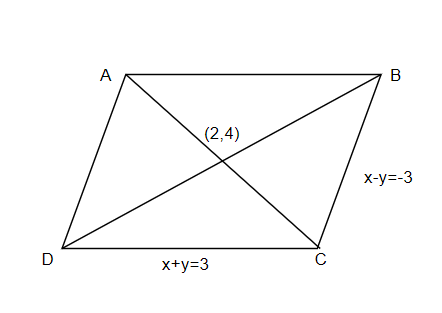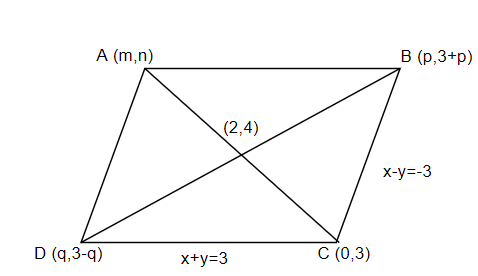
Two sides of a parallelogram are along the lines \[x+y=3\] and \[x-y+3=0\]. If its diagonals
intersect at \[(2,4)\], then one of its vertex is
(a) \[(2,6)\]
(b) \[(2,1)\]
(c) \[(3,5)\]
(d) \[(3,6)\]
Answer
612.6k+ views
Hint: Solve the 2 line equations to find the coordinates of intersection of these 2 lines and use section formula to find the remaining coordinates of a parallelogram.
The equations given in the question are,
\[x+y=3\] and \[x-y+3=0\]
They can be rewritten as,
\[x+y=3\] and \[x-y=-3\]
Also, it is given that the diagonals intersect at \[(2,4)\]. Draw the parallelogram representing the given data as shown below,

AThe vertex C is a point that intersects the lines DC and BC. Therefore, the coordinates of the C can be obtained by adding and solving the two equations of the lines as below,
\[\dfrac{\begin{align}
& x+y=3 \\
& x-y=-3 \\
\end{align}}{\begin{align}
& 2x=0 \\
& x=0 \\
\end{align}}\]
Substituting the value of \[x\], we have the value of \[y\] as,
\[\begin{align}
& 0+y=3 \\
& \Rightarrow y=3 \\
\end{align}\]
Therefore, the coordinates of C are \[(0,3)\].
The coordinates of vertex B can be obtained by supposing \[x=p\]in the equation \[x-y=-3\]. So, we have the coordinates as \[(p,3+p)\]. To get the coordinates of vertex D, suppose \[x=q\]in the equation \[x+y=3\]. So, we have the coordinates as \[(q,3-q)\]. Let the coordinates of vertex A be \[(m,n)\]. The figure can be redrawn with the above details as below,

The coordinates of the point of intersection of the diagonals are given as \[(2,4)\]. The point of intersection is the midpoint of the line AC as well as the line BD. It divides the lines in the ratio \[1:1\].
Using the section formula, the coordinates of vertex A \[(m,n)\] can be found as,
\[\left( \dfrac{m+0}{2},\dfrac{n+3}{2} \right)=\left( 2,4 \right)\]
Equating both coordinates on either sides,
\[\begin{align}
& \dfrac{m}{2}=2,\dfrac{n+3}{2}=4 \\
& m=4,n=(8-3) \\
& m=4,n=5 \\
\end{align}\]
Therefore, coordinates of A are \[(4,5)\].
Using section formula to find the coordinates of D and B,
\[\begin{align}
& \left( \dfrac{p+q}{2},\dfrac{3+p+3-q}{2} \right)=(2,4) \\
& \left( \dfrac{p+q}{2},\dfrac{p-q+6}{2} \right)=(2,4) \\
\end{align}\]
Equating both coordinates on either sides,
\[\begin{align}
& p+q=4,p-q=(8-6) \\
& p+q=4,p-q=2 \\
\end{align}\]
We get two equations \[p+q=4\] and \[p-q=2\]. Adding and solving the two equations,
\[\dfrac{\begin{align}
& p+q=4 \\
& p-q=2 \\
\end{align}}{\begin{align}
& 2p=6 \\
& p=3 \\
\end{align}}\]
Substituting the value of \[p\], we have the value of \[q\] as,
\[\begin{align}
& 3+q=4 \\
& q=1 \\
\end{align}\]
Now, re-substituting these values, we can get the coordinates of B and D as,
B\[(p,3+p)\Rightarrow (3,3+3)=(3,6)\]
D\[(q,3-q)\Rightarrow (1,3-1)=(1,2)\]
Looking at the options, the only possible answer is the coordinates of B, which is \[(3,6)\].
Therefore, we get option (d) as the correct answer.
Note: One way in which this problem could go wrong is by interchanging the coordinates of B and D which are written in terms of \[p\] and \[q\]. If you write the coordinates as \[(3+p,p)\] and \[(3-q,q)\] instead of \[(p,3+p)\]and \[(q,3-q)\], you might end up getting the coordinates as \[(6,3)\] and \[(2,1)\] and choose the wrong option.
The equations given in the question are,
\[x+y=3\] and \[x-y+3=0\]
They can be rewritten as,
\[x+y=3\] and \[x-y=-3\]
Also, it is given that the diagonals intersect at \[(2,4)\]. Draw the parallelogram representing the given data as shown below,

AThe vertex C is a point that intersects the lines DC and BC. Therefore, the coordinates of the C can be obtained by adding and solving the two equations of the lines as below,
\[\dfrac{\begin{align}
& x+y=3 \\
& x-y=-3 \\
\end{align}}{\begin{align}
& 2x=0 \\
& x=0 \\
\end{align}}\]
Substituting the value of \[x\], we have the value of \[y\] as,
\[\begin{align}
& 0+y=3 \\
& \Rightarrow y=3 \\
\end{align}\]
Therefore, the coordinates of C are \[(0,3)\].
The coordinates of vertex B can be obtained by supposing \[x=p\]in the equation \[x-y=-3\]. So, we have the coordinates as \[(p,3+p)\]. To get the coordinates of vertex D, suppose \[x=q\]in the equation \[x+y=3\]. So, we have the coordinates as \[(q,3-q)\]. Let the coordinates of vertex A be \[(m,n)\]. The figure can be redrawn with the above details as below,

The coordinates of the point of intersection of the diagonals are given as \[(2,4)\]. The point of intersection is the midpoint of the line AC as well as the line BD. It divides the lines in the ratio \[1:1\].
Using the section formula, the coordinates of vertex A \[(m,n)\] can be found as,
\[\left( \dfrac{m+0}{2},\dfrac{n+3}{2} \right)=\left( 2,4 \right)\]
Equating both coordinates on either sides,
\[\begin{align}
& \dfrac{m}{2}=2,\dfrac{n+3}{2}=4 \\
& m=4,n=(8-3) \\
& m=4,n=5 \\
\end{align}\]
Therefore, coordinates of A are \[(4,5)\].
Using section formula to find the coordinates of D and B,
\[\begin{align}
& \left( \dfrac{p+q}{2},\dfrac{3+p+3-q}{2} \right)=(2,4) \\
& \left( \dfrac{p+q}{2},\dfrac{p-q+6}{2} \right)=(2,4) \\
\end{align}\]
Equating both coordinates on either sides,
\[\begin{align}
& p+q=4,p-q=(8-6) \\
& p+q=4,p-q=2 \\
\end{align}\]
We get two equations \[p+q=4\] and \[p-q=2\]. Adding and solving the two equations,
\[\dfrac{\begin{align}
& p+q=4 \\
& p-q=2 \\
\end{align}}{\begin{align}
& 2p=6 \\
& p=3 \\
\end{align}}\]
Substituting the value of \[p\], we have the value of \[q\] as,
\[\begin{align}
& 3+q=4 \\
& q=1 \\
\end{align}\]
Now, re-substituting these values, we can get the coordinates of B and D as,
B\[(p,3+p)\Rightarrow (3,3+3)=(3,6)\]
D\[(q,3-q)\Rightarrow (1,3-1)=(1,2)\]
Looking at the options, the only possible answer is the coordinates of B, which is \[(3,6)\].
Therefore, we get option (d) as the correct answer.
Note: One way in which this problem could go wrong is by interchanging the coordinates of B and D which are written in terms of \[p\] and \[q\]. If you write the coordinates as \[(3+p,p)\] and \[(3-q,q)\] instead of \[(p,3+p)\]and \[(q,3-q)\], you might end up getting the coordinates as \[(6,3)\] and \[(2,1)\] and choose the wrong option.
Recently Updated Pages
Master Class 11 Economics: Engaging Questions & Answers for Success

Master Class 11 English: Engaging Questions & Answers for Success

Master Class 11 Social Science: Engaging Questions & Answers for Success

Master Class 11 Biology: Engaging Questions & Answers for Success

Class 11 Question and Answer - Your Ultimate Solutions Guide

Master Class 11 Business Studies: Engaging Questions & Answers for Success

Trending doubts
What is meant by exothermic and endothermic reactions class 11 chemistry CBSE

10 examples of friction in our daily life

One Metric ton is equal to kg A 10000 B 1000 C 100 class 11 physics CBSE

Difference Between Prokaryotic Cells and Eukaryotic Cells

What are Quantum numbers Explain the quantum number class 11 chemistry CBSE

1 Quintal is equal to a 110 kg b 10 kg c 100kg d 1000 class 11 physics CBSE




